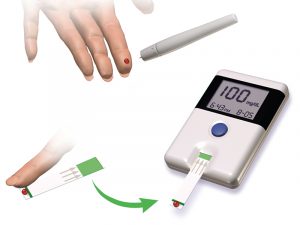Diabetes
Diabetes is a group of metabolic diseases in which a person has a high sugar concentration in their blood. People with diabetes are impaired in their ability to metabolize glucose, a sugar needed by the body for energy; as a result, excessive quantities of glucose accumulate in the blood and the urine. Diabetes may be caused by insufficient insulin production by the pancreas or by the body’s cells not responding properly to the insulin that is produced. In a healthy person, insulin is produced when it is needed and functions to transport glucose from the blood into the cells where it can be used for energy.
The characteristic symptoms of diabetes are weight loss, constant hunger, extreme thirst, and frequent urination (the kidneys excrete large amounts of water in an attempt to remove the excess sugar from the blood). The long-term complications of diabetes can include loss of eyesight, heart disease, and kidney failure. In 2013, it was estimated that approximately 3.3% of the world’s population (~380 million people) suffered from diabetes, resulting in over a million deaths annually. Prevention involves eating a healthy diet, getting plenty of exercise, and maintaining a normal body weight. Treatment involves all of these lifestyle practices and may require injections of insulin.
Even after treatment protocols were introduced, the need to continually monitor their glucose levels posed a challenge for people with diabetes. The first tests required a doctor or lab, and therefore limited access and frequency. Eventually, researchers developed small tablets would react to the presence of glucose in urine, but these still required a relatively complex process. Chemist Helen Free, who was working on improvements to the tablets, conceived a simpler device: a small test strip. With her husband and research partner, Alfred Free, she produced the first such product for measuring glucose; soon after, she expanded the technology to provide test strips for other compounds and conditions. While very recent advances (such as breath tests) have shown promise in replacing test strips, they have been widely used for decades and remain a primary method today.

Glucose is one of the carbohydrates you will learn about in this chapter as we begin to study the chemistry of molecules found in food. Later we will study the other two major types of macromolecules found in foods: fats/oils and proteins.
Attributions
This page is based on “Chemistry 2e” by Paul Flowers, Klaus Theopold, Richard Langley, William R. Robinson, PhD, Openstax which is licensed under CC BY 4.0. Access for free at https://openstax.org/books/chemistry-2e/pages/1-introduction
This page is based on “The Basics of General, Organic, and Biological Chemistry” by David W Ball, John W Hill, Rhonda J Scott, Saylor which is licensed under CC BY-NC-SA 4.0. Access for free at http://saylordotorg.github.io/text_the-basics-of-general-organic-and-biological-chemistry/index.html

